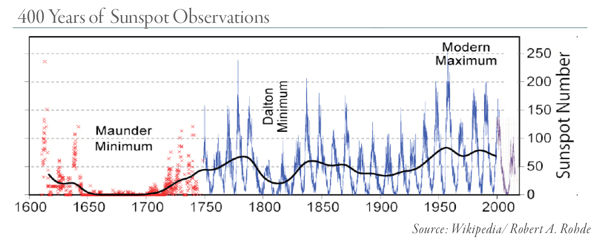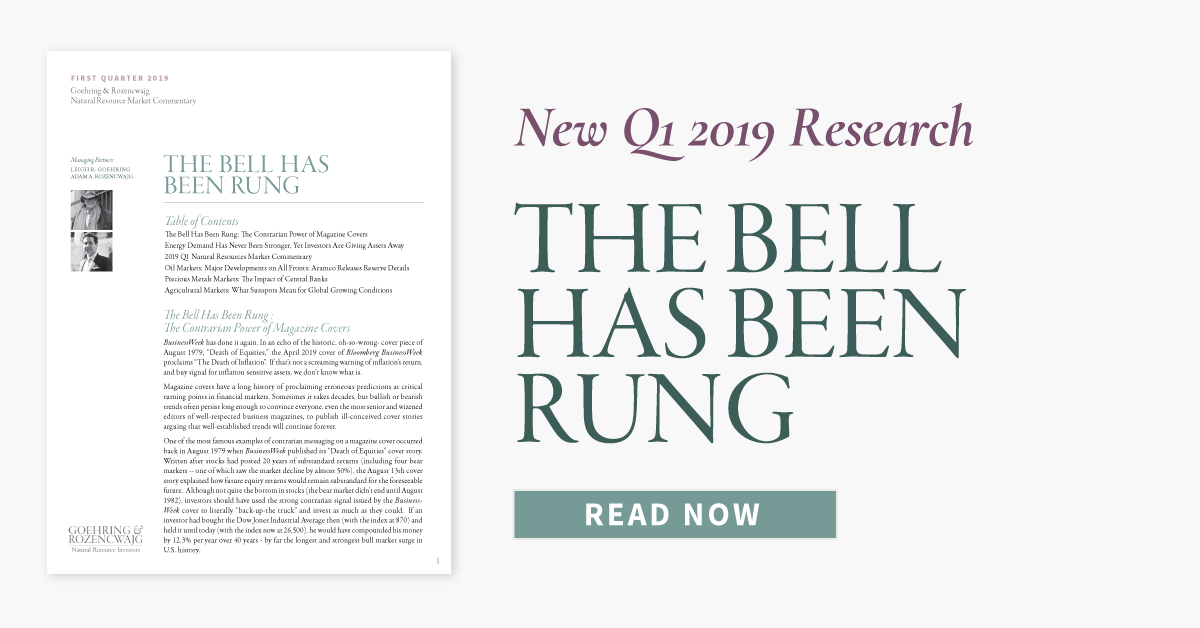We recently pointed out that while it may sound unorthodox, no one has even dared ponder what the effects of a global cooling period would have on crop conditions. If the warming of the past 70 years coincided with surging crop yields, could a period of cooling (however unexpected) have the opposite effect?
We are putting forth two very controversial ideas. Before we begin, we would like to state that we are not trying to weigh in on the impact of CO2 to global warming. Instead, we would like to draw attention to a completely different factor impacting global temperatures. What’s remarkable about this other factor is that no one has paid any attention to it whatsoever. We are contrarian investors and pride ourselves on trying to identify trends that few others have considered. While we admit that the science is far from certain, the implications of what we are about to discuss are important enough that we believe the investment community needs to, at the very least, consider it.
We believe changes are now taking place on the sun’s surface that could ultimately usher in a significant shift in global weather patterns over the next 20 years. If the world were to enter a period of cooling for any reason, our research tells us that global growing conditions could become much more challenging and that the trend of relentlessly-advancing crop yields we have experienced for almost four generations could reverse.
Scientists, astrophysicists, and meteorologists all carry on a vigorous debate regarding the impact on terrestrial weather of the sun’s changing phases. There is no agreement on the subjects we are about to discuss, so please read to what we have to say with an open mind. All we ask is that you decide for yourself. Stories of the financial difficulties faced by farmers today abound. Low grain prices have reduced profits margins to zero while debt financing requirements continue to grow. If we are right about the upcoming change in global weather conditions, the seven-year bear market in grain prices could end in the not-too-distant future causing agricultural-related investments to surge.
Although common wisdom suggests the energy emitted from the sun is extremely stable, nothing could be further than the truth. For reasons not fully understood, the sun undergoes multiple cycles that are repeated over and over. The best-known cycle is the eleven-year sunspot cycle. In 1843 German astronomer Heinrich Schwabe published a paper describing how sunspots ebb and flow according to a cycle that repeats itself every eleven years.

What causes this eleven-year sunspot cycle? Most solar astronomers believe the sun’s magnetic field reverses its polarity every eleven years, causing the development of sunspots to peak and trough in a repeatable cycle. Scholars have observed 24 cycles since 1750. As you can see from the chart above, the trends are easily discernible. The most notable period is the Maunder Minimum. This period was characterized by minimal sunspot activity and occurred between 1645 to 1715 in conjunction with the second half of the Little Ice Age, a period of intense cold which lasted from approximately 1300 to about 1850.
Sunspot activity rebounded in 1750 before exhibiting another period of weak activity between 1790 and 1830, a period known as the Dalton Minimum. Similar to the Maunder Minimum, the Dalton Minimum coincided with the last great surge of extreme cold temperatures that characterized the Little Ice Age. The last “Frost Fair” held in London on the frozen River Thames was in 1814, during the middle of the Dalton Minimum cycle.
The latest trough in sunspot activity occurred at the turn of the 20th century. Since then we have experienced an extended period of high sunspot activity, peaking first in the late 1950s and again in the 1990s. This period, now commonly referenced as the Modern Maximum, broadly coincides with the global warming cycle which also began at the turn of the 20 century and continues today.
The 24th sunspot cycle began in 2008, peaked in 2014 and has most likely ended as we write today. Sunspot activity has declined significantly over the previous two cycles. Although open to debate, many sunspot observers believe that sunspot-cycle 23 will have ended up being the last sunspot cycle of the Modern Maximum cycle.
For reasons that are not fully understood, it does seem that sunspots go through various repeating cycles (including nested cycles within cycles) of varying duration. For example, it is now commonly accepted that the sun produces a geomagnetic storm every 27 days that impacts short-term sunspot activity.
Scientists have gone back and studied ice cores and tree rings in an attempt to correlate them with sunspot activity. These scientists now believe the sun also exhibits much longer cycles which produce periods of high solar magnetic output (corresponding to many sunspots) and low solar magnetic output (corresponding with few or even no sunspots). The Modern Maximum and Maunder Minimum are examples of the former and latter, respectively. Some scientists now believe they have identified an approximately 85-year cycle (the Gleissberg Cycle), a 200-year cycle (the Suess-DeVries Cycle), and a 2,400-year cycle (the Hallstatt Cycle). There is mounting evidence indicating we are entering a potential period of very low sunspot activity, caused by a confluence of overlapping Gleissberg and Suess-DeVries Cycles. If this is indeed the case, the impact on the earth’s climate and by extension growing conditions could be material.
Next week, we will continue this discussion around sunspots, temperatures and plant yields. Please subscribe to our blog to make sure you don’t miss-out on any of our natural resource-related content.
This blog contains excerpts of our in-depth commentary, The Bell Has Been Rung. If you are interested in this subject, we encourage you to download the full commentary here.


